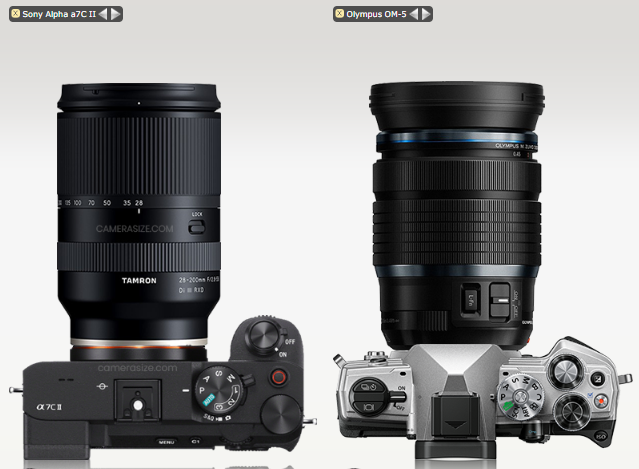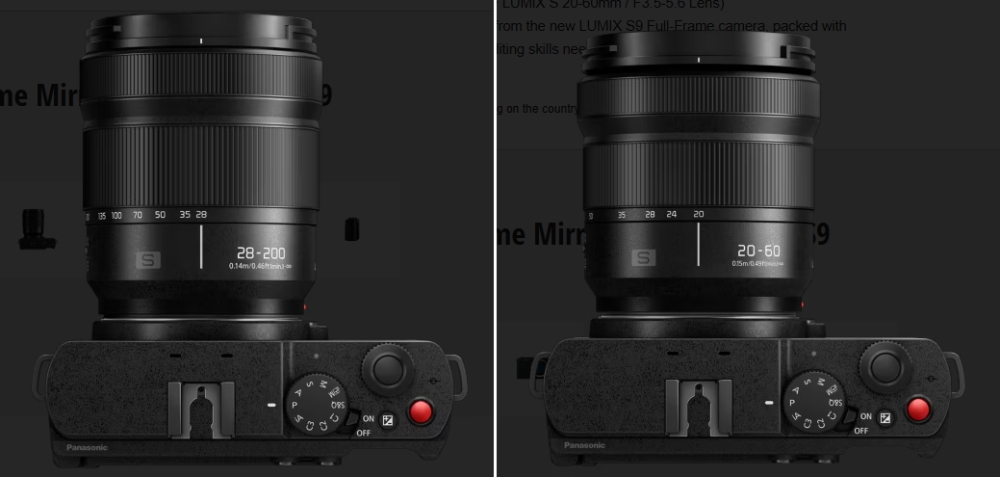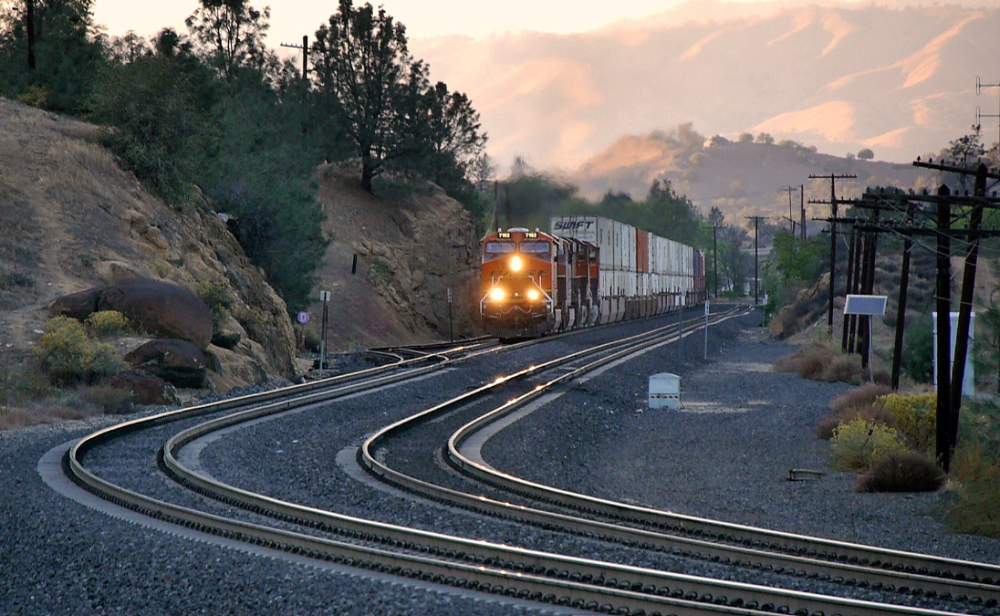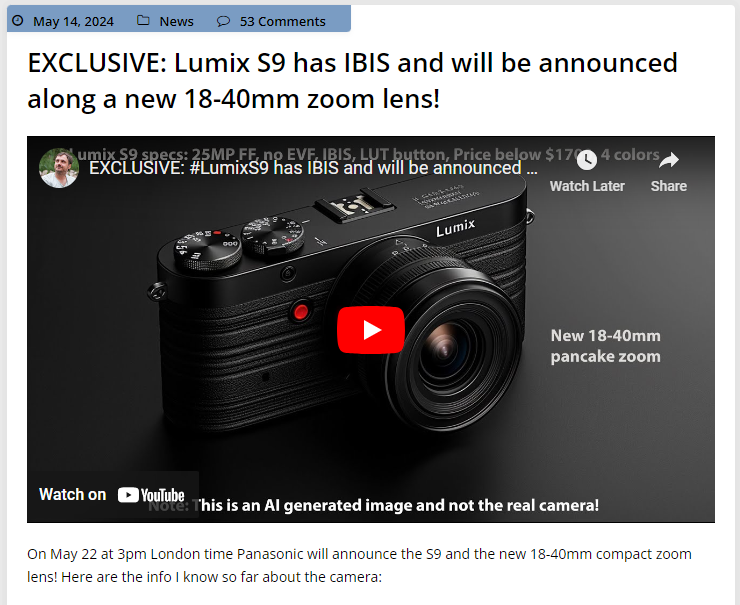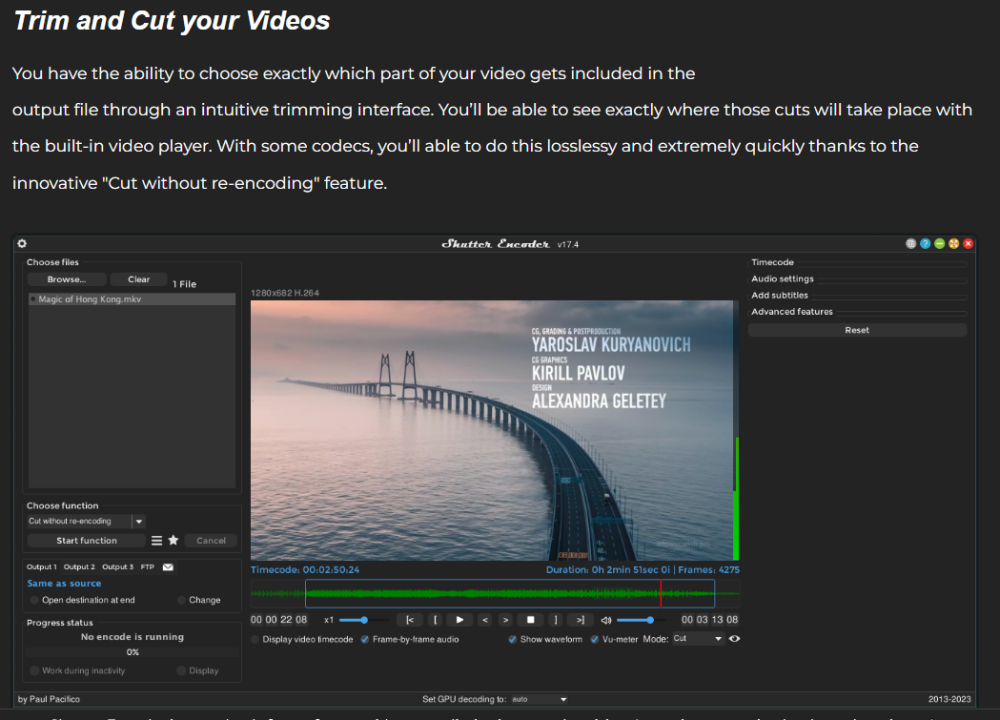
ac6000cw
Members-
Posts
640 -
Joined
-
Last visited
Content Type
Profiles
Forums
Articles
Everything posted by ac6000cw
-
Me too (so far). The problem is nicely illustrated by the FF Tamron 28-200mm f2.8-5.6 versus the m43 Oly/OMDS 12-100mm F4 Pro. The Oly is a great lens, both optically and to use, but it's pretty much the same size and weight as the cheaper the FF Tamron (which covers basically the same FOV as the Oly). Almost certainly the Tamron is far more optically compromised though.
-
The Panasonic S 28-200mm f4-7.1 Macro OIS lens probably gets closest, which at 93 mm long is about 6mm longer than the 20-60mm f3.5-5.6 and about 19mm longer than the m43 14-140mm f3.5-5.6. Another one is the E-mount Tamron 28-200mm f2.8-5.6 - about 25mm longer than the S 28-200mm and 40mm longer than the m43 14-140mm. But both of the FF 28-200mm are only x7 zooms, not the x10 the m43 lens gets you (but that is pretty small for its zoom range).
-
This is S9 versus some similar size MILC alternatives that you can buy new (from the left, ZV-E1, A7C ii, S9, OM-5, X-S20). Paired with what I think are the most compact mid-range zooms currently available from each camera manufacturer. The small size of the 28-60mm f4-5.6 lens on the ZV-E1 and A7C ii does rather make the point that the S9 really needs the upcoming 18-40mm lens (and maybe a compact 28-70mm or 35-100mm).
-
AFAIK, it doesn't have PDAF - it's basically an updated LX100 ii. Now a black and silver LX9 or LX1 with the 4/3 25MP sensor and processing from the G9ii (albeit with inevitably short recording times) would be far more interesting - 21MP stills, PDAF, lens OIS plus great EIS, no-crop 4k and excellent FHD? I'm not holding my breath though, even though I think that's what Panasonic really need to appeal to the upmarket end of the 'cute camera' market as well as the enthusiast compact market.
-
I agree. I would hope that most people are not gullible enough to believe that product reviews are 'warts and all' - they are subjective to varying extents, including what to put in and leave out. If you're getting paid to do it (including payments in kind, like 'free' trips) there is always going to be some 'don't bite the hand that feeds you' pressure around, even if it's not overt from the marketing dept. Magazines need advertising revenue, professional social media content creators need sponsorship income. It's nothing new...
-
It's interesting that the Leica D-Lux 8 has just been announced - https://www.dpreview.com/news/3471020867/leica-continues-compacts-with-d-lux-8-featuring-four-thirds-type-sensor - (looks like same 20MP 4/3 sensor as LX100 ii/D-Lux 7), but with OLED EVF and higher res rear screen, plus USB-C charging). The D-Lux series have always been Leica versions of Panasonic 'enthusiast' compacts, so might an LX100 iii be on the way (as LX100 ii was discontinued a while ago)?
-
I agree. My wife does artistic painting etc. as a fairly serious hobby (to the extent of exhibiting and selling it). At an exhibition it's usually the artists who are the most down-to-earth people in the room, as they know what's involved in creating, promoting and selling it - which is overall a lot of work (just like making decent video content is). Art critics are essentially product reviewers - they look at an art product and tell you what they think about it, sometimes implying 'meaning' in the work that I strongly suspect the original artist never intended (and who is probably dead so can't challenge the opinion). That's no different really to many other sales and marketing activities. He's on my subscription list and I watch some of his content if I'm in the mood for his style and I might be interested in the product he's talking about. But I think he's sometimes got an exaggerated sense of his importance, which grates a bit sometimes.
-
Exactly (GX85 + 14-140mm is my current travel cam). Versus the GX85 or GX9, you get 24MP stills, PDAF, a dual-gain sensor with good high-ISO performance, 4k50p/60p (albeit with a crop but so does the GX85/GX9 in 4k), a higher capacity battery, better stabilization, variable electronic zoom, a mic input, H264 and H26 10-bit recording at (in round numbers) 24/25/30/48/50/60p up to C4K, with higher resolutions up to 30p, at up to 4:2:2 and 200Mbps long-GOP. Viewed as a GX85 & GX9 successor, it makes a lot of sense, especially once the 18-40mm zoom is available. (At the moment, buying used from a dealer in the UK, a GX9 + 14-140mm would cost around £700 - £1000 so that's not a cheap camera either).
-
Panasonic UK have two S9 kits listed on their website, one with the 20-60mm f3.5-5.6, the other with the 28-200mm f4-7.1 Macro OIS lens (but no price as yet for that kit). Comparing the sizes of both on the S9, the 28-200mm kit looks like it might be a nice FF travel cam combination at just under 900g total weight including battery. According to Panasonic W x H x D is 126 x 73.9 x 140.1 mm with the 28-200 (the 20-60 is just 6mm shorter and 63g lighter): Amateur Photographer magazine in the UK has estimated the length of the upcoming compact 18-40mm F4.5-6.3 at around 40mm, which is about half the length of the 20-60mm.
-
It's usually to free up capital tied up in the stock, generate cash to run the company and pay to manufacture new stock of something that is selling better with higher profit margins. Also retailers may get sales volume-based discounts or bonuses from suppliers which are extra income to them.
-
Have a good story to tell that holds the viewers attention. Everything else is secondary, as without that they won't be watching the content for very long anyway.
-
That was Paul Cook - https://vimeo.com/paulcook and https://www.paulcookfilm.com/
-
Lens wise, I think what is needed to pair with the S9 is a collapsible kit zoom like the APS-C Nikon Z 16-50mm f3.5-6.3 but FF so maybe a 24-70mm f4-7.1 ? But as MrSMW said, at the moment a Sigma APS-C 18-50 f2.8 makes a lot of sense for video use as 4k50/60p is APS-C cropped anyway.
-
But that's comparing current 'street' price of S5ii with launch price of S9 - here in the UK the S5ii was around £1999 at launch, £1649 now. I'd expect the S9 to follow the same sort of price curve, by the end of the year it'll probably be at least £200-£300 cheaper (depending on how good sales are). It's pretty obvious that it's designed to be as small and cheap as possible - no mechanical shutter, no headphone jack, no EVF, cold shoe only, minimal dials and buttons. That keeps the build cost down and helps the product cope with 'price erosion' over time. If they were making a more cutting-edge camera it might have a much faster stacked sensor to compensate for the lack of mechanical shutter - but then I suspect everyone would be saying it's nice but way too pricey...
-
From the specs on the Panasonic UK website:
-
When I saw that in one of the videos, I had a sense of déjà vu - some of the old G-series m43 cameras from 10+ years ago had a combined optical plus variable sensor crop zoom system for stills operated by a zoom lever on the body. It was actually quite a nice feature, especially with a power-zoom lens. It was never available for video though. I wonder if the digital zoom feature will be added to the S5ii/iix in a firmware update at some point? As the S9 has no headphone jack, but does have Bluetooth 5.0, why not add basic Bluetooth headphone support to provide some sort of audio monitoring capability? I know there can be latency issues with Bluetooth audio, but it would be a lot better than nothing at all... Personally the lack of a mechanical shutter and the short record times don't bother me, and the variable zoom feature is quite appealing, so I could be tempted when the price drops - I think it's a bit high in comparison with the competition at the moment. BTW the full specs are on the Panasonic website e.g. the UK version - https://www.panasonic.com/uk/consumer/cameras-camcorders/lumix-mirrorless-cameras/lumix-s-full-frame-cameras/dc-s9.html - and most of the standard picture profiles seem to be there (Standard / Vivid / Natural / L. Classic Neo / Flat / Landscape / Portrait / Monochrome / L. Monochrome / L. Monochrome D / L. Monochrome S / LEICA Monochrome / Cinelike D2 / Cinelike V2 / Like709 / V-Log / REAL TIME LUT / Like2100 (HLG) / Like2100 (HLG) Full Range*) so I assume you don't need to mess about with LUTs to get them.
-
4k/UHD video = 8MP stills which I think is perfectly fine even on a large screen at normal viewing distance. One of my favourite photos (which other people have also liked) is only a 2MP JPEG, taken in 2015 with a Pana G6 while simultaneously recording FHD video. It's the light, shade and the sweep of the glinting rails that makes it work, not the resolution:
-
Panasonic S5 II (What does Panasonic have up their sleeve?)
ac6000cw replied to newfoundmass's topic in Cameras
The GX8 (announced in July 2015) was AFAIK the first m43 camera with a 20Mp sensor. I almost bought one at the end of 2015 when Panasonic had a double-cashback promotion running, but didn't as there was no sensor-shift stabilization for video (lens OIS plus EIS for FHD, only lens OIS for 4k), so decided to wait for full video IBIS with dual-IS - eventually buying a G80 when it came out in autumn 2016. That said, whenever I've played with a GX8 in camera stores, I've always liked it (it has a nice 'premium' feel) and thought about buying it used a few times - partly for its large vari-angle viewfinder. -
Panasonic S5 II (What does Panasonic have up their sleeve?)
ac6000cw replied to newfoundmass's topic in Cameras
Yes, but there were quite a lot of adverse review comments about the level of cropping it used, which probably had an adverse effect on sales (for a vlogging targeted camera needing a wide angle of view). I'm sure the S9 will have at least EIS (which Panasonic do very well). If the new 18-40 zoom lens has OIS that might be enough in a dual-IS combination. -
Panasonic S5 II (What does Panasonic have up their sleeve?)
ac6000cw replied to newfoundmass's topic in Cameras
IBIS has been mentioned on l-rumors.com - and personally (given that competition like the a7c ii, ZV-E1 and X100V1 has it) I think it might be a bit suicidal not to include it. -
If you want a nice, free, GUI based tool, 'Shutter Encoder' - https://www.shutterencoder.com/ - uses FFMPEG underneath, supports cutting without re-encoding for some codecs (on keyframe boundaries) and is available for Windows, MacOS and Linux. If you want to re-compress the files to reduce the size, it supports ProRes and many others, including optional GPU hardware acceleration for H264/AVC and H265/HEVC. But always check the new files work properly in your editor before you delete the originals... (I don't have any connection with the tool other than being a satisfied user)
-
Panasonic S5 II (What does Panasonic have up their sleeve?)
ac6000cw replied to newfoundmass's topic in Cameras
As Panasonic are traditionally in the 'high-value' (rather than 'high-price') area of the market, using the Sony 61MP sensor would probably have pushed the price too high. But if the S9 sells well, an S9r would be the obvious spin-off from it. The Sony FF 24MP sensor is almost in the 'bargain basement' area now. It's OK for stills, but it's slow - hence the poor rolling shutter and crop in 4k 50/60p. Maybe an S1H ii might have a much faster FF stacked sensor? - it would be something significant to put it above the S5iix -
The situation with review content being affected by commercial interests is nothing new in the slightest... Many years ago I was asked if I was interested in doing a product review for a now long-gone print magazine. I tried to be as fair as possible when I wrote it, but thought the product had some usability/compatibility issues that needing fixing. The version of the review printed in the magazine had some of my criticism watered-down, I assume partly because advertising revenue related to the product was important to the finances of the magazine. I only did a couple of reviews for the magazine in the end, mostly because the amount they paid for them wasn't much in relation the work involved in testing a product properly (and I wasn't interested in doing quicker, more superficial reviews).
-
Panasonic S5 II (What does Panasonic have up their sleeve?)
ac6000cw replied to newfoundmass's topic in Cameras
A 'walking about in a forest' comparison from Robert May of the S5iix stabilisation modes at 14mm (very wide angle) using the 14-28mm f4-5.6 lens(which doesn't have OIS): Pretty impressive stabilisation performance with minimal warping artefacts. -
A very good strategy for getting the best out of older 8-bit cameras - I think Kye does the same (with a GX85). At the end of the day, unless you tell them, anyone who watches the final movie won't know (or care for the most part) what was used to make it - they'll judge it primarily on the story it tells, be it fictional or documentary, and whether it it's enjoyable/interesting/absorbing. If an old camera does the job and is enjoyable to work with, why not use it? Inanimate tools like cameras, lights and filters can help or hinder the art, but they can't create it...that needs imagination.

